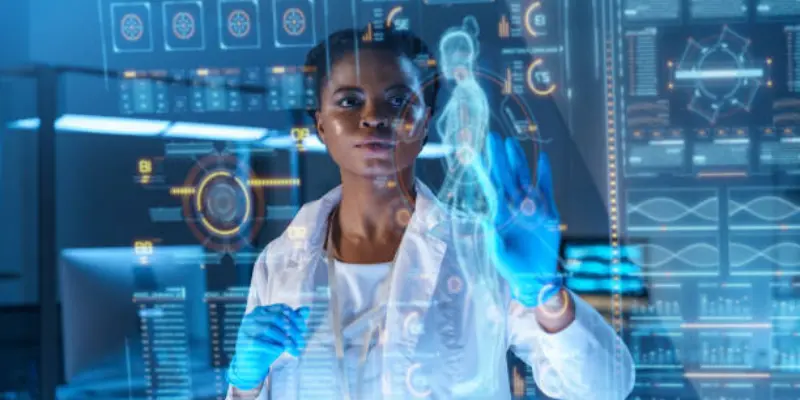AI Software in Medical Imaging Analysis: A Revolutionizing Smart Technology
Published: 2 May 2025
Imagine, Dr. Patel, a radiologist, had to look through hundreds of chest X-rays in one day. Her eyes were tired, and she worried she might miss something important. Now, she uses AI software that scans each image in seconds and highlights anything unusual like a shadow that could mean lung disease. This smart tool does not replace her skills. Instead, it gives her a safety net. That’s the power of AI software in medical imaging analysis which helps tge doctors to spot problems faster and with more confidence.
Today I am back with a new, comprehensive article on AI software use in medical imaging analysis. Let’s start

What is AI software in medical imaging analysis
- AI software in medical imaging analysis is a tool that uses artificial intelligence to examine medical images.
- It works with X-rays, CT scans, MRIs and other types of images.
- It helps to find patterns, detect issues and support diagnosis.
- The software learns from data to improve its accuracy over time.
Why It’s Important Today
AI software in medical imaging analysis is important because it helps doctors find problems faster and more accurately. Hospitals are busy. Radiologists often look at hundreds of images every day. This can lead to fatigue and mistakes. AI helps by spotting tiny details in scans that a human eye might miss. It works fast and supports better decisions, especially in urgent cases like cancer, strokes or lung disease.
How It Will Impact the Future
In the future, this software will become even smarter and It will:
- Predict health problems early by finding patterns before symptoms appear
- Save lives by helping doctors act quickly in emergencies
- Reduce workload for medical staff by handling routine tasks
- Bring better care to remote areas through smart, portable tools
- Work with other health data to give a full picture of a patient’s condition
AI is not replacing doctors. It’s giving them a powerful tool to do their job better.
Features of AI Software in Medical Imaging Analysis
AI software comes with smart features that help doctors read medical images faster and more clearly. These tools make scanning, spotting and diagnosing much easier.
- Image Recognition – Detects patterns and shapes in scans like X-rays, CTs and MRIs.
- Anomaly Detection – Highlights unusual spots that might show signs of disease.
- Segmentation – Separates different parts of the image to focus on organs or problem areas.
- 3D Reconstruction – Turns flat scans into 3D views for better understanding.
- Automatic Reporting – Creates simple reports to save time for doctors.
- Data Learning – Gets smarter over time by learning from past scan results.
- Integration with Hospital Systems – Works smoothly with existing tools like PACS or EHRs.
- Real-Time Alerts – Sends instant warnings when something serious is found.
- Customizable Settings – Lets users adjust tools based on their needs or scan types.
- Secure Data Handling – Keeps patient images and results safe and private.

Applications of AI Software in Medical Imaging Analysis
AI software is now used in many areas of healthcare to make image reading faster, safer and more accurate. It helps doctors to diagnose diseases, track progress and even plan treatments using smart image tools.
- Cancer Detection – Spots early signs of tumors in scans like mammograms and CTs.
- Lung Disease Analysis – Identifies issues such as pneumonia, TB or COVID-19 in chest X-rays.
- Brain Imaging – Helps to detect strokes, brain tumors and other neurological problems in MRIs.
- Bone Fracture Detection – Finds small cracks or breaks in X-rays that are easy to miss.
- Cardiac Imaging – Analyzes heart scans to detect blocked arteries or weak heart muscles.
- Liver and Kidney Scan Review – Examines organs to find signs of disease or damage.
- Eye Disease Screening – Detects conditions like diabetic retinopathy in retinal images.
- Orthopedic Imaging – Reviews joint or spine images to spot arthritis or injuries.
- Follow-up Comparison – Compares past and present images to track recovery or changes.
- Emergency Room Support – Speeds up scan review during urgent cases like trauma or stroke.
Suggested Article: The Role of AI as Caregiver in Healthcare
Advantages and Disadvantages of AI Software in Medical Imaging Analysis
AI software in medical imaging brings numerous benefits but also comes with some challenges. Understanding both sides helps ensure it’s used effectively in healthcare.
| ✅ Advantages: |
|---|
|
| ❌ Disadvantages: |
|---|
|
Top AI Tools for MRI and CT Scan Analysis
AI tools are changing how doctors read MRI and CT scans. These tools help to identify problems quickly, giving doctors more time to focus on patient care. Let’s explore some of the top AI tools used today in MRI and CT scan analysis.
Aidoc
Aidoc is an AI tool that helps radiologists analyze CT scans in real-time. It quickly detects life-threatening conditions such as brain hemorrhages and pulmonary embolisms, by automatically highlighting abnormal areas in scans. This allows healthcare providers to prioritize urgent cases and take immediate action. Aidoc is easy to integrate into existing hospital systems, making it a valuable tool for improving patient outcomes in critical situations.
Zebra Medical Vision
Zebra Medical Vision leverages AI to analyze both MRI and CT scans, identifying over 40 different conditions including heart disease, cancers and neurological disorders. Its ability to provide comprehensive insights helps doctors to make more accurate and timely diagnoses. Zebra’s deep learning algorithms process scans quickly and offer an efficient solution for busy healthcare settings. This tool is particularly useful in detecting subtle abnormalities that may otherwise go unnoticed.
Qure.ai
Qure.ai is an AI-powered tool that specializes in analyzing brain scans, chest X-rays and CT scans. By using deep learning algorithms, Qure.ai detects conditions like strokes, tuberculosis and pneumonia. It provides accurate results that assist doctors in making faster and more informed decisions. With its user-friendly interface and ability to integrate into various hospital systems, Qure.ai enhances the diagnostic process and reduces human error in image interpretation.
VUNO Med
VUNO Med is an AI software designed to analyze CT and MRI scans to detect a range of diseases including cancers, pneumonia and spinal conditions. It uses advanced deep learning techniques to identify patterns in medical images, allowing for early detection and more accurate diagnoses. VUNO Med is easy to use and integrates well with existing hospital systems which makes it a valuable tool for radiologists looking to streamline their workflow and improve patient care.
Brainlab
Brainlab focuses on using AI in medical imaging to assist in neurosurgery. By analyzing CT and MRI scans, Brainlab creates detailed 3D visualizations that help surgeons plan and execute procedures with greater precision. This tool is particularly beneficial for complex surgeries, as it enhances surgical navigation and minimizes risks. While Brainlab is mainly designed for surgical use, its integration with MRI and CT scans offers a significant advancement in neurosurgical planning and patient outcomes.
Also Read: How to Boost your Career in Healthcare
Conclusion
So guys! It’s time to say goodbye, we’ve covered AI software in medical imaging analysis in detail. The AI tools are revolutionizing the way healthcare professionals use MRI and CT scan analysis by making diagnoses faster, more accurate and more reliable. As AI continues to evolve, these tools will only get smarter, providing even greater support for medical professionals and improving patient care. Now is the perfect time to dive deeper into the world of AI software in medical imaging analysis. The future of healthcare is unfolding before us and exploring these innovations can empower you to be part of this exciting transformation.
Related Question – Answers About Medical Imaging Analysis Software
Here are frequently asked questions about AI Software in Medical Imaging:
Current studies show AI can match or sometimes exceed human accuracy in specific tasks but not across all scenarios. The best results come when AI and radiologists work together, combining AI’s consistency with human judgment. Most medical facilities use AI as a supporting tool rather than a replacement for human expertise.
Most healthcare facilities include AI analysis as part of their standard imaging procedures, covered under general consent forms. Specific consent requirements vary by country, region and healthcare system policies. Patients can typically ask their healthcare provider about the role of AI in their diagnosis process if they have concerns.
Medical AI systems must comply with healthcare privacy regulations like HIPAA in the US or GDPR in Europe. Patient data is typically anonymized or de-identified before being processed by AI systems. Most AI tools are integrated within hospital networks rather than sending data to external servers, providing an additional layer of security.
Most radiologists require only minimal training to use modern AI imaging tools due to their user-friendly interfaces. The training typically focuses on understanding the AI’s strengths and limitations rather than technical aspects. Many medical schools now include AI literacy as part of their radiology curriculum to prepare future physicians.
Implementation costs vary widely based on the complexity and scope of the AI system, from thousands to millions of dollars. Many vendors offer subscription-based models that make the technology more accessible to smaller facilities. The return on investment often comes from improved efficiency, reduced errors and better patient outcomes.
Many AI software solutions can work with images from older equipment as long as they meet basic quality standards. Integration might require additional middleware or software adapters to connect legacy systems. Some hospitals upgrade their imaging equipment and AI systems simultaneously for optimal performance.
AI can analyze routine images in seconds, compared to minutes for human radiologists. For complex cases, the speed advantage remains significant, potentially reducing diagnosis time from hours to minutes. This rapid analysis is particularly valuable in emergency situations where time is critical.
Many leading medical imaging AI tools have received FDA clearance in the US or similar approvals in other countries. The approval process typically requires demonstrating safety, effectiveness and clinical validation through studies.
AI systems may struggle with extremely rare conditions that were not well-represented in their training data. Most systems flag unusual patterns they can’t confidently identify for human review. The best AI tools continuously learn from new cases, gradually improving their ability to recognize rare conditions.
Most insurance companies treat AI-assisted diagnoses the same as traditional diagnoses since a physician still oversees the process. Some insurers are beginning to incentivize AI use because it can reduce costly diagnostic errors. Patients generally don’t need to take any special steps regarding insurance when their images are analyzed with AI assistance.





